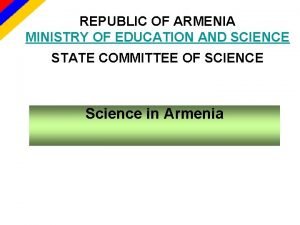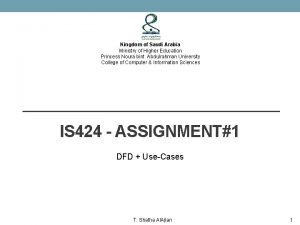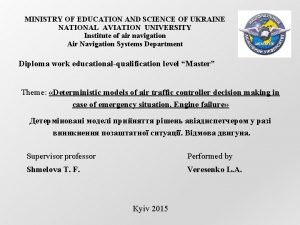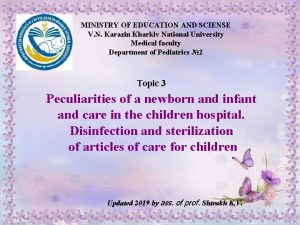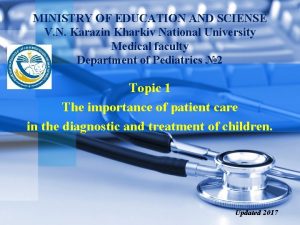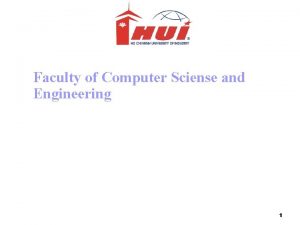MINISTRY OF EDUCATION AND SCIENSE OF UKRAINE V


















































- Slides: 50

MINISTRY OF EDUCATION AND SCIENSE OF UKRAINE V. N. Karazin Kharkiv National University Medical faculty Department of Pediatrics № 2 Topic 2 The admission department Updated 2018 as. Krutenko N.

Functions of the admission department at pediatric hospitals The basic functions of the admission department are as follows: admission of ill children; their hospitalization to a department according to the type of the hospital; giving, if necessary, of urgent aid; organization of the measures, which facilitate prevention of infectious diseases at the hospital; issuance and proper filling in of medical documents.

Functions of the admission department at pediatric hospitals • The admission department should have the organizational-functional structure and the number of relevant premises, which correspond to the type and capacity of the hospital. • It is very important that the staff of the admission department should always treat the ill child with respect, consider his state and the parent's nervousness, and patiently listen to the complaints, presented by the child himself and the people, who accompany him

The work of the admission department is carried out following a certain order: registration of the child, who is admitted to the hospital, in the register of admissions and filling in of the title page of the medical card; examination by the doctor, who records data of the case history and objective examination of the child into his medical inpatient card; initial diagnosis of the disease and giving of the required medical aid; taking of the body temperature and anthropometry (measuring of the body length, weight, head circumference);

The work of the admission department is carried out following a certain order: visual examination of the child for pediculosis and scabies; making of the necessary sanitary cleansing, whose way is administered by the doctor; transportation of the ill child to the department of the appropriate type.

The documents, which are filled in at the admission department of the children's hospital, are as follows: Registers of the patients, admitted to the hospital, and refusal for admission (accounting forms Nos 001/o and 001 1/o); Hospital record (chart, medical history, medical inpatient card) (f. № 003); Statistical card of a patient discharged from hospital (f. № 066); The informed voluntary agreement of the patient to diagnostics, treatment and operation and anesthesia (f. № 003 6); Medication administration record (treatment sheet) f. № 003 4); Abstract of the out patient medical record (f. № 027); Advisory opinion of the expert (f. № 028); Pathology record (f. № 013); Temperature chart (form N 004/o); The emergency notification about infectious disease, the food poisoning, acute professional poisoning, unusual reaction to an inoculation (vaccination) (f. № 058);

Sanitary hygiene regimen at the admission department. An ill person is admitted to hospital through the admission department, where admission, registration, examination, sanitary cleansing and transportation of patients are performed. Keeping of the sanitary hygiene regimen begins at the admission department. The inspection room and bath of the admission department should be kept perfectly clean. The child's examination should be followed by the cleansing of the objects (spatulas, thermometers) and furniture (couches, chairs, etc. ), which the patient touched. Oilcloth pillows and sheets on the couches are to be treated with 0. 2 % solution of Chloranthoin or another disinfectant. Sheets on the couches should be changed after each patient too.

Sanitary hygiene regimen at the admission department. • The sanitary hygiene cleansing of an ill child at the admission department should be performed with regard for the severity of his state. If the child is in need of urgent aid, his sanitary hygiene cleansing should be made after an improvement of his state. • The sanitary inspection unit of the admission department has an examination room, where the child is prepared for a hygienic bath. Before the child is cleansed, the bath should be thoroughly washed.

Pediculesis If the doctor reveals pediculosis, he carries out special disinfection. Pediculosis is infestation on the head, body, or pubic area by lice. The infestation is widespread in those facilities, which are overcrowded or inadequate for personal hygiene or clean clothing. P. humanus capitis is transmitted by personal contacts and such objects as combs and hats. There are three stages in the life cycle of the lice: the nit, the nymph, and the adult louse.

Pediculesis Nits are louse eggs. These are difficult to see and are often confused with dandruff or hair spray droplets. Nits are found firmly attached to the hair shaft. They are oval and usually yellow to white. Nits take about a week to hatch. The adult louse is about the size of a sesame seed, it has 6 legs, and islan to white greyish. In persons with dark hair, the adult louse looks darker. Females lay nits; they are usually larger than males. Adult lice can live up to 30 days on a person's head. To live, adult lice need to feed on blood. If the louse falls off a person, it dies within 2 days.


Pediculesis • Nymphs are baby lice. The nit hatches into a nymph. It looks like an adult head louse, but is smaller. Nymphs mature into adults about 7 days after hatching. To live, the nymph must feed on blood. • Although localized predominantly on the scalp behind the ears and near the neckline at the back of the neck, • P. pubis sometimes involves the eyebrows, eyelashes, and beard. Head lice hold on to hair with their hook like claws that are found at the end of each of their six legs.

Prevention of pediculesis • Prevention of pediculosis and reinfestation includes teaching children and other people to practice good hygiene and to avoid sharing combs, brushes, caps, scarves, and clothing. For effective elimination of head lice, the infested individual, his family members that are also infested, and the home must all be treated.

Treatment of pediculesis The treatment for lice involves using a shampoo, cream rinse, or lotion that contains a medicine that kills lice. Such medicines are known as Pediculicides. Permethrin lotion 1% is approved by the FDA for the treatment of head lice. Permethrin kills live lice but not unhatched eggs. Permethrin may continue to kill newly hatched lice for several days after treatment. A second treatment often is necessary on day 9 to kill any newly hatched lice before they can produce new eggs. Permethrin is approved for use on children 2 months of age and older

Para plus aerosol (exposure time 10 min). Introduction of aerosol is contraindicated in children aged up to 2. 5 years. Other remedies are as follows: Pedilin emulsion, Nix (permethrin) 3 % shampoo; Itax (phenothrin lotion or aerosol 3 % and /o shampoo);

Recommendations for use. STEP 1 • Choose a pediculicide (head lice treatment). Some pediculicides are formulated to kill both lice and their eggs, while others only kill crawling lice. To use a pediculicide, read the instructions on the bottle carefully. • You can get a permethrin 1% creme rinse (such as Nix) or a Pyrethrins 0. 33% shampoo or mousse (such as Rid or Pronto) over the counter at a pharmacy. • Have the person being treated put on old clothes and sit in the bathroom. This makes cleanup easier. Apply the treatment to the hair and scalp according to the instructions on the bottle. • Allow the treatment to sit for the recommended amount of time. It's usually an hour or less (10 min). • Don't leave the treatment on for longer than recommended. Wash out the treatment using water, not shampoo. No shampoo should be used for 2 days.

STEP 2. Comb out the lice with a nit comb. • This step helps to hasten the treatment process if you're using a pediculicide, but you can also get rid of lice using a nit comb alone. • Divide the hair into sections. • Starting at the scalp, pull the comb from the roots to the end of a section of hair. • Swish the comb around in a bowl of warm, soap water. This will kill the lice and their eggs; they die quickly without a source of food. • Continue combing each section of hair until all the hair has been combed. • Sanitize the comb by putting it in a dish of very hot water after every use. Lice and their eggs die when exposed to temperatures of 128 °F (53 °C) for 5 minutes or longer.

STEP 3 Wash the person's clothes and bedding. • After this initial treatment, wash all clothes, sheets, pillowcases, stuffed animals, and any other fabrics the person has come into contact with in very hot water, then run them through a hot dryer. • While lice don't live very long once they jump off a person's head, it's still important to wash everything so you can be extra sure someone else in the family won't get lice. • For items that can't be soaked in hot water, like hairbrushes and hair accessories, place them in plastic bags for at least two weeks. The lice will die without air and food.

Scabies • Scabies (the itch) is a contagious parasitic skin disease, characterized by superficial burrows, intense pruritus, and secondary infection. • The causative agent of scabies is a microscopic itch mite (Sarcoptes scabiei), which is introduced into the stratum corneum of the epidermis (the most superficial layer of human skin). • The source of infection is a sick person with scabies. Incubation period (from the moment of infection to the appearance of signs of the disease), on average, is 7 10 days.

Ectoparasite is the itch mite or Acarus it's shaped like a turtle. The female tick has a broad body with a size of about 0. 3 mm to 0. 45 mm.

• The causative agent of scabies feeds on the Horny scales of the epidermis. Fertilization of the female occurs on the surface of the human skin, the male then dies. • The female is attached to the skin with suckers on the front paws. It drills the horny layer of the epidermis with movements of the jaws, making first vertical ring shaped, barely visible hole, and then parallel to the surface of the skin it digs the S shaped itch moves, the length of which up to 1 3 cm and rarely more. Tick penetrates the epidermis within 15 30 minutes.

• The female is usually located in the head (blind) end of the scabies course, per day moves 1 mm and, periodically stopping, digs holes in the" roof " of the scabies passages, through which air enters, necessary for the life of the parasite.

• For 6 8 weeks of life she lays up to 50 eggs, 3 7 days after laying the larvae emerge , which become sexually mature after 3 molts. The whole cycle takes about 10 14 days. During the period of functional activity, the female allocates a special substance easily absorbed by the skin, which promotes loosening of the stratum corneum of the epidermis and, irritating the nerve endings, causes itching.

Ways of infection 1. Direct contact pathway (direct contact with the patient's skin): sexual intercourse is the most frequent route of infection in adults, household way is a frequent way of infection in children. The skin of children is thinner, delicate, what explains the easy penetration of the pathogen even for short time contact (being in the same bed, on hands, knees, especially in a stripped state). A long, repeated handshake can lead to infection in the presence of rashes in a sick person in the area of the interdigital folds of the hands.

2. Indirect contact path (infection occurs through objects): use bedding, underwear, towels, washcloths sick person. This can lead to infection. In children, infection can occur through toys, if they were previously used by a sick child.

Manifestations of scabies The main symptoms of scabies: itching, increasing in the evenings, especially in bed, itchy passages in the skin, the typical localization of lesions, linear combs on the skin. The increase in itching in the evening and at night is due to the daily increase in the activity of mites at this time and the release of their secret, which softens the stratum corneum of the skin and irritates the nerve endings. Scabies moves are localized mainly in areas with the largest thickness of the stratum corneum.

They are most often found: in the interdigital folds of the brushes (the brushes are a "mirror" of scabies); on the flexor surface of the wrist joints; on the inner surface of the forearms and shoulders; on the trunk; on the feet; on the abdomen below the navel; the buttocks and the crease mezhyagodichnoy; around the nipples in women; on the foreskin and head of the penis; on the palms; on the soles; on the face and head of small children.



Diagnostics

Dermatoscopy • This is a mandatory study in the recognition of scabies. In the case of classical course dermatoscopy always gives a reliable result. With scabies without moves, the study helps to make a positive diagnosis only in a third of cases. • The drawback of this method is inefficient identify the causative agent in papules and vesicles. If scabies occurs without the formation of moves, dermatoscopy will not be reliable. In such cases, the scraping is carried out.

Scraping Before harvesting the biomaterial, the patient's skin is moistened with lactic acid or weak alkali, after which the epidermal cells are better separated. In addition, take a scraping from under the patient's nails. This is the best way of laboratory diagnosis of scabies, so it is used more often than others. Analysis on scabies is to obtain biological material and subsequent microscopy.

Ink test is an auxiliary diagnostic method that helps to detect scabious moves on the skin, if they are not visible. The sequence of actions: the skin is applied to the blue ink; washed off with ethanol; scabious course is manifested in the form of a colored trace. Instead of ink, you can use iodine, aniline compounds

Treatment of scabies • Currently, for the treatment of scabies, a fairly large number of drugs and schemes are used. Table 1 presents the drugs most commonly used in dermatological practice, with an assessment of their effectiveness • Medication Efficiency , % containing sulphur 95 benzyl benzoate 73 87 lindane 60 80 crotamiton 72 90 esdepallethrine 80 91 In any case, before starting therapy, it is advisable to take a hot shower, using a washcloth and soap, for the purpose of mechanical removal from the surface of the skin of ticks, the secretion of sebaceous glands, as well as for loosening the surface layer of the epidermis, which, in turn, facilitates the penetration of anti scabies drugs. However, water treatments are contraindicated in the presence of secondary pyoderma.

"Spregal" (esdepallethrine) aerosol is used to treat scabies even in infants. Often enough to use within 1 day. Treatment consists in spraying the drug at a distance of 20 30 cm from the skin. After 12 hours, the drug is thoroughly washed off. Treatment is convenient to carry out in the evening, the drug acts during the night, in the morning after washing treatment ends. After 3 days, treatment with spregal should be repeated. All contact with the patient should also be treated with spray. One bottle of aerosol is enough for 2 3 people. "Spregal" is not used or used for 3 5 days according to the schemes of treatment of scabies with complicated secondary infection of long existing scabies.

Permethrin Cream 5% for Scabies It has low toxicity and excellent results. It is at least as effective as lindane (Hexit, Odan Laboratories Ltd, Canada; PMS Lindane, Pharmascience Inc, Canada) and more effective than crotamiton Thoroughly wash and dry skin. Massage the cream into the skin from the head to the soles of the feet, paying special attention to creases in the skin, hands, feet, between fingers and toes, underarms, and groin. Scabies rarely infests the scalp of adults, although the hairline, neck, side of the head, and forehead may be infested in older people and in infants. Infants should be treated on the scalp, side of the head, and forehead. Leave the permethrin cream on the skin for 8 to 14 hours. Wash off by taking a shower or bath. Put on clean clothes. After treatment, itching may continue for up to 4 weeks. !!! It is not recommended for infants younger than two months of age, but has been used successfully and safely in a 23 day old infant.

Lindane cream or lotion is an alternative when 5% permethrin is not available. It should be washed off after 12 h and reapplied 24 h later. Lindane should be prescribed cautiously for infants younger than two years of age, and in pregnant and lactating women.

Benzyl benzoate • is the drug of choice in the treatment of scabies. The active substance of the drug benzyl benzoate penetrates into the body of mites and kills them, being a neurotoxin. • For the treatment of children under 3 years, a 10% solution is used, which is prepared by diluting 20% of the suspension with an equal volume of boiled water.

Benzyl benzoate The emulsion before use is thoroughly shaken, and then rubbed with hands in the entire skin, except for the head, face and neck. Treatment lasts 2 days: 2 consecutive rubbing for 10 minutes with a 10 minute break between them. But after such treatment, some larvae remain alive, hatch and penetrate the skin. As a result, there is a relapse of scabies. Therefore, the method is modified: the emulsion of benzyl benzoate is rubbed in the 1 st and 4 th days of treatment. The patient before rubbing the emulsion should take a bath and wash thoroughly with soap and a washcloth. Underwear and bed linen should be changed twice: after the first and second rubbing of the drug. Then 3 days do not wash, then a hot shower and again to change the sheets.

Crotamiton The active ingredient of the drug – crotamiton. The medicine is available in the form of cream or lotion. The drug is rubbed into the skin twice after 24 hours. After the second rubbing, it should take two days before the patient can take a shower. The product is contraindicated in children under 12 years. It should not be applied to bleeding and wet skin surfaces.

• Precipitated sulphur (7%) in petroleum jelly is a safe alternative therapy for very young infants, and pregnant and lactating women. It is applied on three consecutive days, left on for 24 h after application and washed off before the next application • Bubil shampoo (Pirethrin 180 mg and acetic acid 600 mg).

CONTROL MEASURES The following control measures are recommended. To prevent reinfection, treat all household members at the same time as the patient is being treated. All bed linen (sheets, pillow cases, blankets) and clothing worn next to the skin (underwear, T shirts, socks, pants) should be laundered in a hot cycle wash and hot drying cycle. If hot water is not available, place all linen and clothing into plastic bags and store it away from the family for five to seven days. The mite does not survive beyond four days without skin contact.

CONTROL MEASURES In widespread scabies epidemics, prophylactic treatment of the whole community may be optimal Children may return to day care or school the day after treatment is completed. Health care workers who have close contact with scabies patients may require prophylactic treatment. Community education (ie, early recognition and awareness of scabies) is recommended.

Disinfection • The system of measures, aimed at killing of causative agents of diseases and creating conditions for prevention of their spread in the environment, is termed disinfection. • The latter is divided into focal, which is performed in the focus of infection, and prophylactic. • Depending upon the time of its carrying out, focal disinfection is subdivided into current and final.

Disinfection � Current disinfection consists in neutralization of all causative agents of any disease immediately after their revealing from the source of infection: cleansing of the patient's objects (bedpan, objects for nursing patients, bedclothes and underwear, tableware, etc. ). � Current disinfection is of paramount importance in intestinal infections. The room, where the patient stays, should be systematically cleaned with water; his toys, table ware, etc. , are to be boiled. Ultraviolet irradiation (with quartz lamps) of the premises, where iil children stay, is one of current disinfection measures in droplet infections; during this process, the children are taken out to other premises.

Disinfection Final disinfection in the focus is performed by workers of a disinfection station, after the infectious disease is eliminated (hospitalization or full recovery of the patient). This disinfection should embrace the premises, where the patient was, all the household articles and clothes of the patient. For disinfecting the premises, mechanical cleaning (washing, bleaching) with disinfectant solutions should be used. Bedclothes and underwear, tableware and household articles are to be cleansed in the same way as during current disinfection.

Disinfection Prophylactic disinfection is carried on for preventing infectious diseases at medical prophylactic establishments. This includes disinfection of water (boiling), washing of baths, washing of wards with disinfectant solutions after the patients' discharge, washing of hands before eating, pasteurization or boiling of milk, fight against carriers of causative agents of infectious diseases. In order to perform disinfection, physical (mechanical, thermal, radial) and chemical ways are used.

Disinfection The mechanical disinfection includes: washing of linen, washing of hands, airing of wards, removal of dust and mud (by means of a vacuum cleaner, a moist rag, etc. ). The thermal disinfection includes: boiling, ironing, burning, treatment with water steam (at pressure chambers), hot air sterilization (at hot air sterilizers). The thermal way is used to disinfect objects for nursing patients, tableware, bedclothes and underwear.

Disinfection • The radial ways consist of: ultraviolet irradiation (with quartz lamps), ultrasound, radioactive irradiation. These ways are used for disinfecting wards and treatment rooms. • The chemical ways of disinfection are the commonest ones and consist in using different disinfectant solutions. These are antiseptics for hands, skin and mucous membranes, disinfectant agents for cleansing solid surfaces, instruments and equipment, as well as for cleaning premies with water. All these agents are to be used in accordance with the instructions attached.

 Ministry of infrastructure (ukraine)
Ministry of infrastructure (ukraine) Preschool primary secondary
Preschool primary secondary Ministry of education and research romania
Ministry of education and research romania Ministry of education and culture cyprus
Ministry of education and culture cyprus Hellenic ministry of education and religious affairs
Hellenic ministry of education and religious affairs Ministry of education romania
Ministry of education romania Ministry of education and science of the russian federation
Ministry of education and science of the russian federation Ministry of education serbia
Ministry of education serbia What is textbook
What is textbook Matriculation certificate
Matriculation certificate Ministry of education armenia
Ministry of education armenia Ministry of higher education (afghanistan)
Ministry of higher education (afghanistan) Ministry of education
Ministry of education Ministry of higher education krg
Ministry of higher education krg Kurdistan
Kurdistan Krg ministry of higher education
Krg ministry of higher education Ministry of higher education saudi arabia
Ministry of higher education saudi arabia Ministry of education iceland
Ministry of education iceland Ministry of national education morocco
Ministry of national education morocco Ministry of education
Ministry of education Ministry of education
Ministry of education Ministry of education peru
Ministry of education peru Ministry of education secondary engagement program
Ministry of education secondary engagement program Ministry of education
Ministry of education Ministry of education
Ministry of education Ministry of higher education kurdistan
Ministry of higher education kurdistan Ministry of national education romania
Ministry of national education romania Ministry of higher education tunisia
Ministry of higher education tunisia Ministry of education moldova
Ministry of education moldova Ministry of education zone 1
Ministry of education zone 1 Ministry of higher education saudi arabia
Ministry of higher education saudi arabia Science and technology center in ukraine (stcu)
Science and technology center in ukraine (stcu) Whats ukraines flag
Whats ukraines flag Language of ukraine
Language of ukraine The geographical position of ukraine
The geographical position of ukraine Ukraine geographical position
Ukraine geographical position Language in ukraine
Language in ukraine Welches brot isst man in der ukraine
Welches brot isst man in der ukraine Ukrainian alphabet
Ukrainian alphabet Bsopen
Bsopen Ukraine european
Ukraine european Ukraine national symbols
Ukraine national symbols Accreditation ukraine
Accreditation ukraine National accreditation agency of ukraine
National accreditation agency of ukraine Zorro ukraine
Zorro ukraine Alexanderhilf ukraine
Alexanderhilf ukraine Dmc in ukraine
Dmc in ukraine Automatic ct system
Automatic ct system Transinvest service ukraine
Transinvest service ukraine Age structure ukraine
Age structure ukraine Bila tserkva national agrarian university
Bila tserkva national agrarian university










